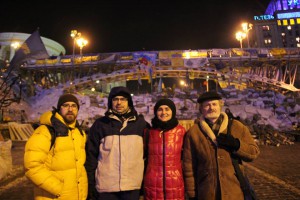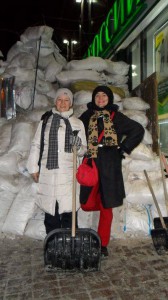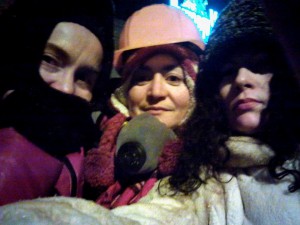Monday
Scene and HeardThe Drala of Maidan
Interviews from the Front
part 1
compiled by Ella Reznikova and Sarah Lipton
Ella is Ukrainian by birth, and Sarah has Ukrainian ancestry
Ukraine is in the midst of a powerful and intense revolution. It has become known as “The Revolution of Dignity”. We have spoken over Skype and email with five of our Shambhala brothers and sisters who are there, experiencing the revolution from the center to find out what it is really like, and to see how we here in the West can help them.
“I felt pain in my heart all day after hearing about the people who were killed. This pain was a sign to me that I too must go there to Maidan Square. I was ready to die if it would be necessary,” says Andriy Kucherenko.
“I would not call it mindless anarchy,” says Alexsey Mikanchuk, “I think it is wisdom social-action, not personal action.”
“Never in my life have I soaked in such bravery, warmth and confidence,” says Ira Vorobiova who has been going to Maidan every day for the last few months.
“In fact, there are moments of goodness every day on this earth,” says Sakyong Mipham Rinpoche in Supreme Thought. “When these disparate moments are arranged as society, good existence can be reality. Therefore, in the Shambhala teachings, the world society, in relationship to politics, means, that, as opposed to deceit and vindictiveness, the interaction between individuals can have dignity. That is the power of basic goodness: a good and truly enlightened society can occur.”
These two months in Maidan Square have changed people. Something has happened to them. They have become real citizens of a real country, says Ella. They are protecting their country as if it is a real entity, a living, vibrating energy, a real mother that is abused and needs help from her sons and daughters. And they are willing to help at any price. What happened, Ella wonders. My friends and my fellow citizens are willing to die? I can feel that they are not just saying, they really mean it.Maidan Square is the epicenter for the revolutionary movement. When you go there, you enter a very particular environment, a society that has four gates with watchful guards. Anybody can enter, except cars. You immediately feel warmth, openness, camaraderie and friendship. You enter your family – you want to go there, you are drawn by something that you dreamed of all your life – a society of good and caring people. The people gathered represent different regions, nationalities, religious orientations and so on. But it doesn’t matter. “It’s been two months since people have been there now. Going there felt like encountering my country’s drala. There is some power that everyone can feel,” Andriy says.
Shastri Maks Lan shares that it is a, “Very, very challenging time for the life in our society. Everything that was stagnant and moving slowly in this country has blown up now. The worst part is the emanation of aggression from all sides. There is the pure anger from those who are judged by corrupt magistrates and are bitten by the police who openly serve the bandits. Then there are the people from the other side of the barricades, those people who are afraid of any change, afraid of Europe and the West. There is aggression, fear and mutual distrust,” Shastri Lan says.
“I heard that Maidan is very peaceful,” questions Ella.
“How it is possible?” Shastri Lan responds. “If your car is burned… your friend is kidnapped and taken to the woods and tortured – it is impossible not to be angry. People hate Yanukovych, and Berkyt (the special police unit) and everyone who supports them.” But from the other side, he says, “Maidan is the lightest and purest place on this planet.”
This sounds a little contradictory to us. “What makes Maidan pure?” asks Ella.
Shastri Lan has two thoughts: “First, everyone who is in Maidan is not there for themselves, but for the goodness of others, even if it is in the future. It is the best kind of naiveté – but in reality there is great sincerity to their presence.”
Secondly, Shastri Lan says, “They (we) enter a fear zone by making the decision to enter the Square. In this place, all masks that we usually wear and all games we usually play are dissolving. While communicating with people you face their naked authenticity, genuineness and simplicity. Because the danger is there, the most beautiful features of humanity get exposed. They are totally obvious and present.”
Ira has been going to the Square every day since the revolution began. She also has a contradictory story to share. “There is no aggression. But I think the most difficult part to explain to people is the essence of our revolution. The authorities and criminals want to give up the independence of Ukraine to Putin. But the citizens don’t agree. We want our country, our place on this earth.”Ira continues saying, “I learn from the other people inside the square. There are so many wounded and humiliated people. The police and criminals work together. More than 140 people have been arrested and around 100 have disappeared. We cannot find them. Four young men are dead. Just today 20 activist’s cars got burned. There are more than a thousand wounded and humiliated people. The police are on the hunt for the most bright and talented people. There are professional snipers. Three of the most famous activists were kidnapped and tortured in the woods. They cut an ear off and crucified the inventor of AutoMaidan, Dmytro Bulatov. He miraculously survived and his friends sent him to the hospital where they tried to arrest him. Now he has left the country and the president of Lithuania was personally concerned about his safety. The police keep trying to kidnap people from the hospitals. But we help them.”
Ira continues, “We don’t care what happens, but nobody will give up. Every day we do something useful for Maidan. Some of our people have guns who will protect us.”
“I don’t blame them (the protestors who were violent against the police) even though I would never act violently,” Alexsey shares. “I’m very sorry about the police who were attacked. But in that situation it was an act of disparate people who were exhausted from two months of standing in the cold without any luck.” The frustrating combination of the inaction of the opposition and the blindness and deafness of the president drove people mad, he says.
Alexsey continues, “Watching your TV, you might think people here are aggressive. Everybody abroad likes to show the pictures of the street riots. But if you had been following the situation here for years you would notice that people here are fantastically patient! They can tolerate a lot, they can stand a long time. I was standing with them, and I saw how peaceful and tolerant people can be when needed.” Because the people are united, they are a nation, and because there is not much diversity, the people don’t like fighting. “We are much more concerned about our families, home and well being.” But, Alexsey says, “If you frazzle them out they can be outrageously selfless and will go till the end to defend their freedom.”
Andriy, who lives in Lviv, describes how the power concentrated in Maidan, saying that once the government used force on the students in the square, there was a great uprising of emotion in Ukraine and people began to stream to the square in support of the students. “It’s difficult to contain this energy with no vision, but it is not total chaos because the people are so strongly together,” he says.
Last time there was an explosion set by the police, people were killed. It was at this point that Andriy (and Shastri Maks Lan) among others decided it was his turn to go to the square. “I was ready to go and do battle,” Andriy says. “For me it was not a difficult choice. Because I am Buddhist and a Kasung, when people are being killed, this is the last straw.” He prepared completely, packing a tarp, warm clothes, a snowboarding helmet he happened to have, and some other tools including an axe. “But I didn’t use all these things,” Andriy explains, “I drove my car across the country and decided to go there without a date to come back. I was thinking to go in and see what the situation was. At that point the situation started to change a little bit. Leaders from the opposition and from the government decided to let go and leave. The situation started to be better.”
Maidan has its own life, says Ira. “Everybody has a job to do. Our boys are in military training. They have impeccable discipline, order in the highest sense. There is a food area, a library, a clinic, and security.” The barricades have even been decorated beautifully and artistically. It is like a government inside of the government with all its attributes. “The only difference,” Ira says, “is that everything is so sweet, and everybody really cares about each other. We are learning everything from how to build barricades to Molotov cocktails. We are becoming adults, a real mature society.”
Spectacular images of riots and clashes in the streets of the Ukrainian capital Kiev have made the rounds of newspapers and social media in the past weeks. A new video by Max Zabolotnyi, however, shows a completely different side of the protests. This video was previously published on the Huffington Post.
https://www.youtube.com/watch?feature=player_embedded&v=GSFVCios0I0
Maidan has its own way, Ira says, like an army. There are platoons, commanders, posts and orders. Each platoon has it’s own task – kitchen, fire, medicine, etc. There are also regional divisions since people are from all parts of Ukraine. Some strong women can join, but mostly they take care of multiple tasks such as kitchen, medical care, propaganda, flyers, and little strikes around the courts as well as visiting hospitals. Everything is structured and under control, says Ira.
The scene in Maidan Square is like a movie, Ira says. “Hollywood should take a rest: knights, Cossaks, crusaders, and all other parts of society are ready to die for each other.”
“When I was inside Maidan, I was talking with everyone,” Andriy shares. “People were completely friendly inside. People were from all different parts of Ukraine, differing political sides of Ukraine, all of it. There were completely different social levels interacting with each other. Rich people were engaging with poor people, and for once it didn’t matter how you got there – whether by private car, metro, or on foot.”
To be continued…







